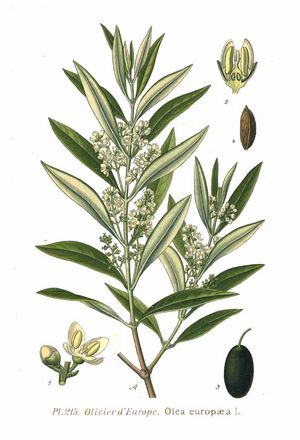Olive – European oils
Family Oleaceae - Oil
Olive - description of plants
Evergreen tree, height 15 m; bark gray to gray-black, crack; young branches gray, covered with scales. Leaves almost sessile, opposite, lanceolate or obovate, tselnokraynie, leathery, glabrous, duck's egg, melkocheshuychatye. Flowers dioecious or polygamous, collected in multi-colored inflorescences axillary or apical acinar or thyroid inflorescences. Cup and 4-lobed corolla. Fruit elliptical or oval (drupes), almost round, with juicy middle and a rocky solid, interior; unripe fruit is green, mature - Black, brownish-green or whitish. It blooms in April - May.
Spread. Wild olive tree found in the Mediterranean region and southwest Asia. Even in ancient times grew its cultivated forms. This form is grown and now the vast plantations in the Mediterranean, Portugal, in Crimea, North Africa (thence culture plants moved to America).
Raw materials. Completely ripe fruit with seeds removed and subjected to cold pressing is used to produce good-quality oil. Olive oil can be obtained by hot pressing, But it turns out this way oil is lower quality and has a specific smell.

The content of active substances in the olive tree
Fruits contain 40-60% fatty oil, seeds - about 20% (average oil content in the fruits about 10-40%). Besides, contains enzymes, Dyes, bitterness, etc.. Fatty oil - yellowish liquid, It has a pleasant buttery taste and a faint characteristic odor. In its composition includes: glycerides of oleic (70-80%), linoleic, palmitic and stearic acids. At 0 ° C, the oil solidifies and turns into a crystalline mass like butter. The leaves contain glycosides, organic acid, mannyt, Rubber, bitterness, flavo-noidы, tannins, etc..
The main effect of drug olives
Oil - zhelchegonnoe; leaves - hypotensive, Crown-rorasshiryayuschee, antiarrhythmic.
Experimental and clinical evidence of therapeutic action of the olive tree
Lately we carried out detailed experimental and pharmacological studies of isolated from the leaves of the olive tree and the chemical study of iridoids and oleuropein. Established, in experiments on anesthetized cats normotensivnyh and chronic experiments on dogs, which was caused by experimental hypertension, that oleuropein is pronounced and lasting more than 5 hours gipotensivny effect. This effect is due to the central and peripheral action. The second main feature of the pharmacological characteristics of the oleuropein is its effect vasodilatig. On some models, the experimental arrhythmia oleuropein has clearly expressed antiarrhythmic effect. Oleuropein has also antispasmodic effect.
The use of olives in folk medicine
In some countries it is used empirically olive leaf extract for the treatment of high blood pressure. The above experimental data indicate the rationality of such a therapeutic method.
Olive oil - a good tool for bile flow (holagognoe), especially in cholelithiasis. It also acts as a mild laxative, and non-irritating, and can facilitate the state for bleeding hemorrhoids. Especially suitable laxative it is for children and malnourished people. Recommend to use it and inflammatory diseases of the stomach and intestines, as well as in case of poisoning fluids, Causes burns of the mucous membrane of the stomach and intestines. Olive oil is also a good emollient for external application in the treatment of solid crust formed on ulcers — apply compresses of warm olive oil. Olive oil lubricated osadiny, and also places the skin, stung by wasps and bees.
Methods of application olives in folk medicine
- For removing gallstones - 60 ml olive oil (best after a strong contraction of the gallbladder), caused by pre-medication, eg, gipofizinom.
- In France, an alcohol tincture of the kidneys olive leaves used to treat hypertension, atherosclerosis and disorders of lipid metabolism.
- Many medicinal plants are used cooked in olive oil. It can be applied in the preparation of the various ointments and cosmetics.
